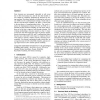Free Online Productivity Tools
i2Speak
i2Symbol
i2OCR
iTex2Img
iWeb2Print
iWeb2Shot
i2Type
iPdf2Split
iPdf2Merge
i2Bopomofo
i2Arabic
i2Style
i2Image
i2PDF
iLatex2Rtf
Sci2ools
DAC
2009
ACM
2009
ACM
Improving testability and soft-error resilience through retiming
State elements are increasingly vulnerable to soft errors due to their decreasing size, and the fact that latched errors cannot be completely eliminated by electrical or timing masking. Most prior methods of reducing the soft-error rate (SER) involve combinational redesign, which tends to add area and decrease testability, the latter a concern due to the prevalence of manufacturing defects. Our work explores the fundamental relations between the SER of sequential circuits and their testability in scan mode, and appears to be the first to improve both through retiming. Our retiming methodology relocates registers so that 1) registers become less observable with respect to primary outputs, thereby decreasing overall SER, and 2) combinational nodes become more observable with respect to registers (but not with respect to primary outputs), thereby increasing scantestability. We present experimental results which show an average decrease of 42% in the SER of latches, and an average improve...
DAC 2009 | Decrease Testability | Design Automation | Reliability Keywords Testability | Testability General Terms |
| Added | 12 Nov 2009 |
| Updated | 12 Nov 2009 |
| Type | Conference |
| Year | 2009 |
| Where | DAC |
| Authors | Smita Krishnaswamy, Igor L. Markov, John P. Hayes |
Comments (0)

